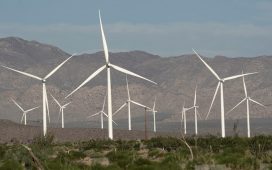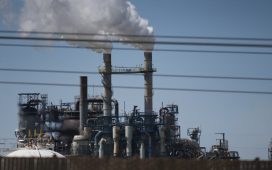
null
Since the close of World War II, the United States has overseen an expanding global order built on fossil fuels. That era has come to an end. Where coal powered the British Empire, and oil powered the American Century, renewable energy technologies are now set to drive the post-American world. Europe’s “Green Deal” represents the beginning of this new era.
The most ambitious clean energy project in history, Europe’s Green Deal marks the beginning of a new era in clean energy policy. Notwithstanding its challenges, Europe’s plan represents a “broad roadmap” for remaking its entire economy with the aim of creating the first climate-neutral region in the world by 2050. Underwritten by one trillion Euros in investment, the Green Deal calls for establishing the first-ever climate law anchored to the 2050 climate neutrality target.

European flags in front of the Berlaymont building, headquarters of the European commission in … [+]
The Green Economy: Europe + China
Beyond Europe, the Green Deal could be the answer to China’s cleantech ambitions as well. With China’s renewable energy growth slowing and its fossil fuel use rising, Europe represents a much needed market to accelerate Chinese cleantech innovation. The EU is China’s largest trading partner and most of this trade is in industrial and manufactured goods. With growing bilateral trade between the EU and China topping over 1 billion Euros per day, the potential for trade in clean energy technologies is vast.
China is of course the world’s largest manufacturer and distributor of cleantech, but it is also the world’s largest carbon emitter. As the world’s manufacturing hub, China remains the largest producer of solar panels, wind turbines, batteries and electric vehicles, but it is also the top investor in clean energy. In addition to this, China is the world’s leader in renewable energy patents with the U.S., Japan, and Europe lagging behind. Together with China, the EU’s Green Deal could successfully remake the economy of Europe and much of Asia.

Aerial view Container cargo ship
Shifting to Cleantech
The fact of the matter is that Europe needs China to move the dial on climate change. China produces more than a quarter of global greenhouse gases— more than Europe and the U.S. combined. But China needs Europe as well. The ecological damage wrought by Asia’s industrialization is accelerating the region’s environmental collapse. Atmospheric pollution, water pollution, and water scarcity are now widespread. Of the 100 most polluted cities in the world, 99 are in Asia.
The larger significance of a green EU-China partnership is that it would provide the economies of scale and scope that the world desperately needs. Together, China and Europe could make it much cheaper for other regions in Asia, Africa, and Latin America to decarbonize. China is already globally dominant in renewables, electric vehicles (EV), energy storage, rail infrastructure, artificial intelligence (AI), telecommunications, and robotics. Even as the country’s rapidly expanding heft now rivals the United States, its massive capacity for cleantech production could effectively move the world beyond fossil fuels.
Europe’s shift to cleantech also blends perfectly with China’s expanding Belt and Road Initiative (BRI). The largest infrastructure project in history, BRI investments include 131 countries supporting two-thirds of the world’s population. The sheer size of the project extends China’s global influence but it also undercuts American predominance. In the United States, the BRI has largely been dismissed as neocolonial debt-trap diplomacy, but the reality is that it is underwriting a new global order. Even as the era of American hegemony winds down, a Eurasian supercontinent is building up.
The End of the American Era
Empires rise and fall. As Eliot Cohen observes, President Trump marks the end of the American era. The U.S. remains a superpower, but its waning influence is obvious. Consumed by unchecked corporate greed, America’s political system has been cannibalized by a rapacious elite. Distracted by the specter of China as an “imperial competitor,” America is sinking into a morass of incompetence and corruption. The global balance of power is shifting and the world order is realigning around regional blocs.
At home, the United States faces the real possibility of social and political implosion. Its market-led society has given birth to a kind of corporate feudalism that has effectively nullified its democracy. As Jeffrey Sachs points out, each U.S. election cycle now costs $8 billion or more, and is routinely subverted by billionaires, Big Oil, the military-industrial complex, and the private health-care lobby. To put this in perspective, the richest four hundred Americans now have more wealth than 185 million of their fellow citizens.

Jiangsu,China
Greening Eurasia
Beyond America’s collapsing fossil fuel empire lies the green economy. Global energy demand is expected to rise 50% by 2050 with the majority of that demand coming from Asia. Investments in new power generation capacity will expand by $10.2 trillion over the next two decades. Fortunately, the bulk of that investment— nearly $7.4 trillion—will be in renewable energy generating capacity. Together, a Green BRI and Europe’s Green Deal could provide a definitive energy transformation. This would be a boon to both Europe and China. But it would also be a boon to the dozens of Eurasian countries spread out between them.
Once the global leader in renewable technologies, China’s leadership appears to be ebbing as its economy slows. Chinese investment in clean energy has plummeted since 2017, shrinking from $76 billon in early 2017 to $29 billion in early 2019. More problematically, Chinese state banks have earmarked $30 billion in funding to build coal-fired power plants in other countries through BRI. Nonetheless, following Europe’s lead China could play a substantial role in the shift to a green economy. To take only one example, China’s Huawei is both the world’s largest supplier of telecom equipment, and one of the world’s largest suppliers of solar inverters for solar panels.
Notwithstanding criticism of China’s “neo-colonial” role in Africa, Latin America and South-East Asia, the reality is that Chinese infrastructure coupled to European planning could ensure significant opportunities for the spread of renewables globally. As a recent report by the World Wildlife Fund points out, the scale of BRI means sustainable technologies and practices are critical to managing an accelerating ecological crisis. China’s deep pools of capital and skilled manufacturing together with Europe’s advanced engineering and planning could facilitate a clean energy future across Asia, the Middle East, Europe, and Africa. Beyond America’s fading empire, what is needed is a coordinated push for major public-private investment in green infrastructure and clean technologies. Together China and Europe hold the key.








